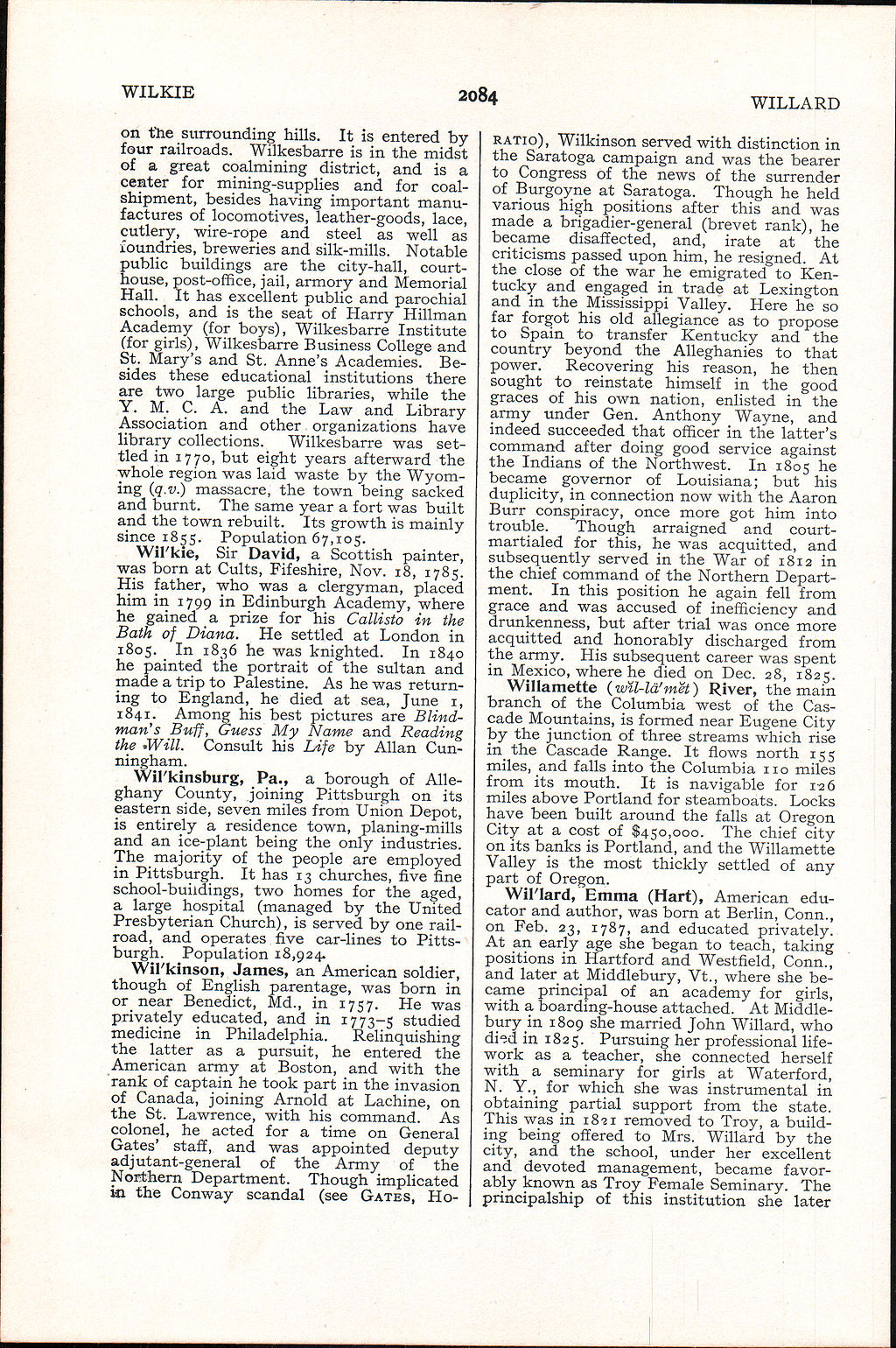WILKIE
2084
WILLARD
on the surrounding hills. It is entered by four railroads. Wilkesbarre is in the midst of a great coalmining district, and is a cemter for mining-supplies and for coal-shipment, besides having important manufactures of locomotives, leather-goods, lace, cutlery, wire-rope and steel as well as foundries, breweries and silk-mills. Notable public buildings are the city-hall, courthouse, post-office, jail, armory and Memorial Hall. It has excellent public and parochial schools, and is the seat of Harry Hillman Academy (for boys), Wilkesbarre Institute (for girls), Wilkesbarre Business College and St. Mary's and St. Anne's Academies. Besides these educational institutions there are two large public libraries, while the Y. M. C. A. and the Law and Library Association and other organizations have library collections. Wilkesbarre was settled in 1770, but eight years afterward the whole region was laid waste by the Wyoming (q.v.) massacre, the town being sacked and burnt. The same year a fort was built and the town rebuilt. Its growth is mainly since 1855. Population 67,105.
Wil'kie, Sir David, a Scottish painter, was born at Cults, Fifeshire, Nov. 18, 1785. His father, who was a clergyman, placed him in 1799 in Edinburgh Academy, where he gained a prize for his Callisto in the Bath of Diana. He settled at London in 1805. In 1836 he was knighted. In 1840 he painted the portrait of the sultan and made a trip to Palestine. As he was returning to England, he died at sea, June i, 1841. Among his best pictures are Blind-man's Buff, Guess My Name and Reading the Will. Consult his Life by Allan Cunningham.
Wil'kinsburg, Pa., a borough of Alle-ghany County, joining Pittsburgh on its eastern side, seven miles from Union Depot, is entirely a residence town, planing-mills and an ice-plant being the only industries. The majority of the people are employed in Pittsburgh. It has 13 churches, five fine school-buildings, two homes for the aged, a large hospital (managed by the United Presbyterian Church), is served by one railroad, and operates five car-lines to Pittsburgh. Population 18,924.
Wil'kinson, James, an American soldier, though of English parentage, was born in or near Benedict, Md., in 1757. He was privately educated, and in 1773-5 studied medicine in Philadelphia. Relinquishing the latter as a pursuit, he entered the American army at Boston, and with the rank of captain he took part in the invasion of Canada, joining Arnold at Lachine, on the St. Lawrence, with his command. As colonel, he acted for a time on General Gates' staff, and was appointed deputy adjutant-general of the Army; of the Northern Department. Though implicated m the Con way scandal (see GATES, HO-
RATIO), Wilkinson served with distinction in the Saratoga campaign and was the bearer to Congress of the news of the surrender of Burgoyne at Saratoga. Though he held various high positions after this and was made a brigadier-general (brevet rank), he became disaffected, and, irate at the criticisms passed upon him, he resigned. At the close of the war he emigrated to Kentucky and engaged in trade at Lexington and in the Mississippi Valley. Here he so far forgot his old allegiance as to propose to Spain to transfer Kentucky and the country beyond the Alleghanies to that power. Recovering his reason, he then sought to reinstate himself in the good graces of his own nation, enlisted in the army under Gen. Anthony Wayne, and indeed succeeded that officer in the latter's command after doing good service against the Indians of the Northwest. In 1805 he became governor of Louisiana; but his duplicity, in connection now with the Aaron Burr conspiracy, once more got him into trouble. Though arraigned and court-martialed for this, he was acquitted, and subsequently served in the War of 1812 in the chief command of the Northern Department. In this position he again fell from grace and was accused of inefficiency and drunkenness, but after trial was once more acquitted and honorably discharged from the army. His subsequent career was spent in Mexico, where he died on Dec. 28, 1825.
Willamette (iml-ld'met) River, the main branch of the Columbia west of the Cascade Mountains, is formed near Eugene City by the junction of three streams which rise in the Cascade Range. It flows north 155 miles, and falls into the Columbia no miles from its mouth. It is navigable for 1-26 miles above Portland for steamboats. Locks have been built around the falls at Oregon City at a cost of $450,000. The chief city on its banks is Portland, and the Willamette Valley is the most thickly settled of any part of Oregon.
Wil'lard, Emma (Hart), American educator and author, was born at Berlin, Conn., on Feb. 23, 1787, and educated privately. At an early age she began to teach, taking positions in Hartford and Westfield, Conn., and later at Middlebury, Vt., where she became principal of an academy for girls, with a boarding-house attached. At Middle-bury in 1809 she married John Willard, who died in 1825. Pursuing her professional life-work as a teacher, she connected herself with a seminary for girls at Wat erf or d, N. Y., for which she was instrumental in obtaining partial support from the state. This was in 1821 removed to Troy, a building being offered to Mrs. Willard by the city, and the school, under her excellent and devoted management, became favorably known as Troy Female Seminary. The principalship of this institution she later
